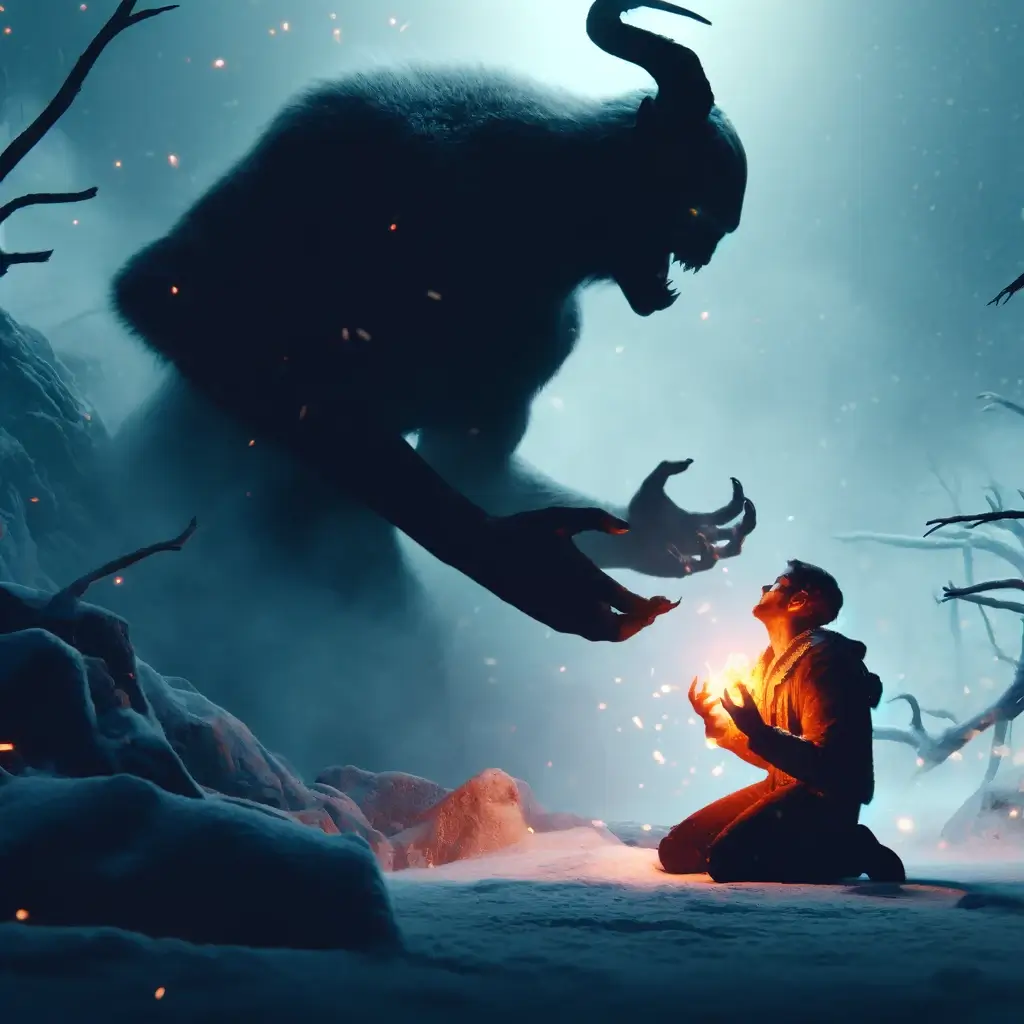Description: Zinnia is a diminutive gnome with skin the color of pale cremini mushrooms and hair that resembles white coral. Glowing bioluminescent fungi sprout from her back, casting an eerie green light. Her eyes are large and black, lacking irises, and she speaks in a raspy, high-pitched voice. She wears a patchwork leather armor adorned with pouches filled with strange, luminous spores.
Personality Traits:
- Curious: Zinnia has an insatiable thirst for knowledge about the underdark and its fungal inhabitants.
- Reclusive: She prefers the company of fungi to other living beings, but can be surprisingly helpful to those who earn her trust.
- Cautious: Zinnia is wary of the dangers of the underdark and will avoid unnecessary risks.
Stat Block:
- Type: Monstrous Humanoid (Gnome)
- Alignment: Neutral Good
- Armor Class: 16 (leather armor)
- Hit Points: 22 (4d6 + 4)
- Speed: 25 ft.
Actions:
- Dagger: Melee Weapon Attack: +4 to hit, reach 5 ft., one target. Hit: 5 (1d4 + 2) piercing damage.
- Spore Burst (Recharge 5-6): Zinnia throws a vial of luminous spores in a 15-foot cone. Creatures in the cone must make a DC 12 Constitution saving throw, taking 3 (1d6) poison damage on a failed save, or 1 (1d6) damage on a success.
Ability Scores: STR 8 (-1), DEX 14 (+2), CON 12 (+1), INT 16 (+3), WIS 15 (+2), CHA 10 (+0)
Saving Throws: INT +5, WIS +4
Skills:
Perception +5, Investigation +6, Nature +5
Fungal Cartography
- Placement: Add this within a new section titled “Skills and Abilities,” potentially between her Stat Block and Relationships section.
- Expanded Description:
- Fungal Cartography: Zinnia’s deep connection to the mycelial network allows her to decipher hidden patterns in the growth of underground fungi. When presented with ancient carvings, blueprints, or maps obscured by fungal growth, she can reveal their true meaning. This ability functions like a skill check, with Zinnia’s proficiency bonus added to the player’s relevant check (Arcana or History, depending on the nature of the document).
Underground Echolocation
- Placement: This fits nicely under “Knowledge & Information” within her “Player Interactions” section.
- Expanded Description:
- Underground Echolocation: By carefully releasing spores and observing how they move, Zinnia can interpret minute changes in air currents and subtle vibrations echoing through cave systems. This grants her insights into the surrounding environment (detecting hidden passages, unstable areas, the presence of distant creatures). It acts as an enhanced Perception check with her proficiency bonus, potentially followed by a Nature check to interpret the specific meaning of the spore movements.
Senses: Darkvision 60 ft., passive Perception 15
Languages: Common, Undercommon
Challenge: 1/4
Relationships:
- The Mycelia Network: Zinnia considers the vast network of fungal life beneath the surface a living entity and communicates with it through a form of bioluminescent signaling.
Encounters:
- Players might encounter Zinnia deep within a network of caves, meticulously studying a new species of glowing mushroom.
- She could be a prisoner of a group of duergar who are trying to exploit the bioluminescent properties of her fungi.
Player Interactions:
Knowledge & Information
- Underdark Guide: Zinnia’s extensive knowledge of the fungal ecology makes her a valuable source of information on:
- Safe vs. hazardous mushrooms and plants.
- Identifying potential threats or strange creatures unique to the subterranean environment.
- Locating hidden paths, resources, or lost ruins with clues based on fungal growth patterns.
- Whispers of the Mycelia: Zinnia might be able to interpret subtle signs the party would miss, as the fungal network senses tremors, shifting air currents, or the distant movement of creatures.
Assistance & Quests
- Spore Power: Zinnia’s vials of spores open up possibilities:
- Distracting or disorienting foes in combat.
- Illuminating dark areas for a short duration.
- Temporarily marking a path with bioluminescent clusters.
- Fungal Remedies: She might know how to craft simple potions or salves from unique underground ingredients, offering healing or temporary buffs.
- Escort Missions: Zinnia could require protection as she retrieves rare spore samples or maps the edges of the fungal network.
Social & Roleplaying
- Wonder and Curiosity: Players can discuss the mysteries and beauty of the underground world with Zinnia, sharing discoveries or learning new perspectives.
- Gifts & Exchange: Offering food and supplies from the surface world might build trust. In return, Zinnia could offer unique, foraged trinkets with minor magical properties.
- Bridging Differences: If the party includes races traditionally hostile to underdark denizens (dwarves, drow), Zinnia’s presence could open up an opportunity for roleplaying negotiation and breaking down stereotypes.
Important Considerations
- Gaining Trust: Zinnia is likely wary of strangers. Players should approach with respect and avoid actions that might damage the fungal environment.
- Communication Barrier: Her speech patterns and understanding of surface-world customs might be limited, creating opportunities for both misunderstandings and heartwarming moments of connection.
Adventure Plot Twists:
Adventure Plot Hook 1: The Lost Dwarven City
- The Whispers: Zinnia begins picking up unusual ‘signals’ from the Mycelia Network. Not just the usual flow of environmental data, but a rhythmic pattern, almost like a form of communication through bioluminescent pulses and subtle vibrations.
- Dwarven Traces: This signal originates from a previously unexplored section of the Underdark. As Zinnia deciphers it, she uncovers hints of ancient dwarven architecture—tunnels carved with a specific method, fungal growth patterns that align with known dwarven masonry techniques.
- Potential Rewards: The city could hold:
- Lost treasures and relics of dwarven history.
- Unique tools or knowledge from a forgotten era.
- Clues to the fate of the original inhabitants.
- Complications:
- The city might be occupied by dangerous creatures who’ve taken over the ruins.
- Duergar, seeking to exploit dwarven secrets, might also be tracking the signal.
- Environmental hazards within the city due to age and neglect.
Adventure Plot Hook 2: The Mycelial Cure
- The Affliction: A nearby settlement (surface or underground) is suffering from a mysterious illness. Healers are baffled, as symptoms don’t match known diseases, and natural remedies fail.
- Fungal Hope: Zinnia discovers that a specific, incredibly rare bioluminescent mushroom seems to alleviate the symptoms temporarily.
- The Quest: The true cure likely involves either:
- Finding a concentrated source of this mushroom deep within the Underdark.
- Understanding its properties and synthesizing a potion with the help of skilled alchemists.
- Obstacles:
- The rare mushroom might grow in a dangerous location guarded by strange creatures.
- Rivals seeking the cure could lead to conflict (desperate townsfolk, a greedy merchant guild).
- Time is of the essence, as the illness might quickly escalate into a full-blown epidemic.
Adventure Plot Hook 3: Hidden Paths
- Setup: The players are traveling through a particularly dense and confusing part of the underdark, becoming frustrated with the lack of progress. A random encounter or subtle cues (faint bioluminescence, the smell of wet earth) leads them near a seemingly unremarkable cave wall.
- Zinnia’s Knowledge: If encountered, Zinnia reveals that she has been mapping a hidden fungal network within these caves. Specific types of mushrooms act as portals, momentarily opening passages to seemingly disconnected spaces.
- The Challenge: Using Zinnia’s knowledge (or their own ability to perceive her clues) players must locate these specific mushroom clusters. Interacting with them might require skill checks (Nature to identify the correct species, Survival to navigate a sudden rush of spore-filled air as the passage opens).
- The Reward: The hidden path could offer:
- a shortcut to their intended destination
- a vantage point for ambush
- an escape route from a dangerous situation
- Nature (Intelligence):
- DC 12: Identifying the correct type of mushroom that acts as a portal.
- DC 15: Understanding the more subtle signs left by Zinnia (patterns of bioluminescence, specific spore clusters)
- Survival (Wisdom):
- DC 13: Navigating a sudden rush of spore-filled air as the passageway opens.
- DC 16: Enduring the disorienting effects of the transition through the fungal passage.
Adventure Plot Hook 4: Symbiotic Beast
- Setup: Strange sounds reminiscent of chitin scraping against stone echo from a side tunnel. If players investigate, they see Zinnia struggling against a large, bioluminescent beetle the size of a pony. The beetle appears wounded and disoriented.
- The Dilemma: The beetle is in pain, thrashing and potentially endangering both Zinnia and the party. However, Zinnia explains that this creature is essential to her survival and she refuses to harm it.
- Possible Actions:
- Players might have skills or spells to calm or heal the beast.
- They may need to find a specific mushroom that has soothing properties, requiring a mini-scavenger hunt guided by Zinnia’s knowledge.
- If combat is unavoidable, Zinnia aids the players but prioritizes mitigating harm to her beetle.
- Outcome: Helping Zinnia strengthens their bond. She may later offer the players a ride on the giant beetle which can navigate terrain others beasts of burden cannot.
- Medicine (Wisdom):
- DC 12: Diagnosing the basic ailment afflicting the beetle (poisoned, wounded, etc.)
- DC 15: Determining the specific cause of the beetle’s distress.
- Nature (Intelligence):
- DC 13: Recalling which types of mushrooms have soothing or healing properties.
- DC 16: Identifying the correct mushroom amongst a cluster of similar-looking species.
- Animal Handling (Wisdom):
- DC 10: Calming the panicked beetle with gentle actions and soothing words.
- DC 14: Carefully administering a potion or applying a healing balm to the beetle.
How to Integrate Zinnia
Both these hooks heavily feature Zinnia as a vital guide and potential problem-solver. However, highlight that she’s not simply a walking answer key. Success still depends on the player characters’ abilities:
- Navigating dangerous caves, fighting off threats.
- Social encounters to gather information or gain the assistance of skilled individuals (the alchemist, a dwarven historian).
- Solving environmental puzzles or mysteries related to the lost city or the mushroom’s properties.
Boxed text (Read Aloud): As you delve deeper into the cavern, you see a faint green glow emanating from a nearby passage. Following the light, you come across a small gnome unlike any you’ve seen before. Her skin is pale and dotted with luminous fungi, and her eyes are large and black. She looks up at you, startled, and raises a hand in greeting.
Description: Zinnia the Myconaut seems more curious than afraid. She gestures for you to approach and, in a raspy voice, asks who you are and what brings you to this part of the underdark.
Background:
- Origin: Zinnia could belong to a hidden underground gnome community known for their strong connection with fungi. She would be an outlier with a special drive for exploration and discovery.
- The Incident: Perhaps Zinnia was once lost and alone in the depths. Her survival relied upon learning to communicate with and derive sustenance from the fungi, creating a profound bond.
Quirks and Flaws:
- Language of the Fungi: Zinnia’s speech might be peppered with words and phrases mimicking the sounds of the underground, like the trickling of water or the rustling of fungal spores.
- Fungus Dependency: She might need to consume a certain type of mushroom to refresh her innate magical abilities, introducing a fun resource management element for the players.
Role in the Story:
- Hidden Paths: Zinnia could know of secret tunnels and passages only accessible through the fungal network, granting the party unusual shortcuts or advantages.
- Threat Interpreter: She could decipher the warnings and messages whispered by the underground network, sensing the buildup of monstrous activity or natural disasters (cave-ins, spore hazards) before they occur.
Additional Encounters:
- Symbiotic Beast: Zinnia might be found accompanied by a small creature, like a giant beetle, with whom she shares a symbiotic life-cycle. The beetle helps her spread spores and in turn feeds on the luminescent fungi.
- Fungal Rival: Another gnome or even a villainous myconid (fungal humanoid) could be vying for the same resources or knowledge as Zinnia, leading to conflict and moral dilemmas for the party.
Introducing the Rival: Korak, the Myconid Sovereign
- Race: Myconid (A sentient, anthropomorphic fungus creature)
- Personality: Arrogant and territorial. Korak believes the fungal network belongs to the myconids alone and views all other creatures with suspicion. He sees Zinnia’s bond with the network as a betrayal.
- Motivation: Korak desires to expand the myconid colony’s reach, even if it means subjugating other underground ecosystems or clashing with other inhabitants. He views Zinnia’s knowledge as a tool to further his goals.
- Abilities: Korak possesses the standard myconid abilities (rapport spores, animating spores) but is larger and more powerful than a standard specimen. He might also have developed unique spells or potions using rare fungal ingredients.
- Insight (Wisdom):
- DC 13: Sensing Korak’s manipulative intentions when he tells his version of events.
- DC 17: Seeing through a disguise or noticing the subtle effects of his rapport spores.
- Perception (Wisdom):
- DC 12: Noticing the early signs of fungal corruption in an area.
- DC 14: Spotting hidden myconid followers during an ambush.
Possible Encounters and Twists
- Ambush: Korak and his myconid followers ambush Zinnia and the players in an attempt to capture her. The goal would be to either force her cooperation or eliminate her as a threat.
- The Corruption: Players stumble upon an area seemingly overtaken by strange, fleshy fungi. Korak is experimenting with aggressive strains that might threaten to destabilize the underdark’s delicate balance.
- Moral Dilemma: Korak could approach the players, seeking their help removing Zinnia under the guise of stopping a threat. He paints her as a potential harbinger of fungal overgrowth, sowing discord.
- Unlikely Alliance: A greater threat forces Korak and Zinnia into a desperate, temporary alliance. Perhaps a powerful aberration or an encroaching force from the surface disrupts the underdark, and only their combined knowledge can help mitigate the danger.
Additional Considerations
- Korak’s Followers: What kind of myconids serve Korak? Are they simple drones or twisted, sentient creatures influenced by his spores?
- Factional Conflict: Could there be other factions within the myconid society opposing Korak’s methods?
- Manipulation: Korak might be particularly dangerous if he’s skillful at using rapport spores to subtly influence others to his cause, turning allies against Zinnia or the players themselves.
Lore
Origin #1: Hidden Community
- The Myconaut Clan: Zinnia belongs to a small enclave of gnomes called the Myconaut Clan. They live far below the surface in harmony with the fungal network, their homes partially fashioned from living fungi.
- Keepers of Knowledge: The Myconauts are less focused on traditional gnomish inventions and more on understanding the underdark’s ecosystem through their bond with the network. They are quiet and reclusive, rarely venturing to the surface.
- Zinnia’s Exceptionalism: Even amongst the Myconauts, Zinnia’s connection is unusually potent. This makes her both revered as a potential leader and slightly feared, as if her ability is slightly unnatural.
- The Departure: Zinnia wasn’t driven out but felt a restless urge to explore. Either her elders sent her to be a reluctant ambassador or she left secretly, yearning to see what lay beyond her village.
Origin #2: The Lost Child
- A Careless Venture: Zinnia’s people might be less isolated, occasionally trading with other underdark settlements. During one such visit, young Zinnia wandered off and became trapped due to an unexpected tremor or attack.
- The Fungal Embrace: Facing certain death, Zinnia stumbled upon a cavern filled with bioluminescent fungi. A desperate attempt to eat them for sustenance triggered an unexpected, symbiotic connection.
- Survival and Growth: Over years, Zinnia learned to decipher the network’s whispers, gain sustenance from different fungi, and even use the bioluminescence to ward off dangerous creatures.
- Scars and Legacy: Zinnia may have witnessed the death of her family while lost in the depths. This could add a touch of melancholy beneath her curiosity and drive her protective bond with her symbiotic beetle.
Combination Approach
- Zinnia was a Myconaut child who felt like an outsider due to her strong potential.
- A daring exploration turns into a tragedy, leaving her orphaned and alone far from her home.
- Her innate skills and the Myconaut knowledge serve as the foundations of survival, pushing her abilities in new directions.
- Does she harbor lingering hope of finding her lost village, or has her isolation formed her into a unique being?
Lore Details & Integration
- Whispered Secrets: Particularly potent when Zinnia touches plants in ancient places. The images and emotions might be overwhelming for her, forcing players to help her interpret them.
- Dietary Needs: Not just any mushroom will do. She might require rare species found only in specific underdark locations, making resource quests necessary.
- Ritual Echoes: Zinnia performs small, subconscious rituals when at ease – humming a tonal pattern that influences fungal growth, offering a spore from her beetle as thanks before consuming a fungus. These hint at her origin without outright explanation.
Remember:
- DC Difficulty: Adjust DCs based on your party’s level and abilities. Lower DCs make things easier, while higher DCs represent more challenging tasks.
- Alternative Skills: Depending on your players’ descriptions, you might allow alternative skills. (Arcana instead of Nature to understand magical fungal properties, or Athletics to break open a passageway blocked by fungal growth).
- Roleplaying: Encourage descriptions and roleplay alongside the checks, allowing players to succeed in creative ways!






































